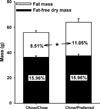Consummatory, anxiety-related and metabolic adaptations in female rats with alternating access to preferred food
- PMID: 18842344
- PMCID: PMC3224792
- DOI: 10.1016/j.psyneuen.2008.08.010
Consummatory, anxiety-related and metabolic adaptations in female rats with alternating access to preferred food
Abstract
Avoidance of and relapse to palatable foods is a qualitative aspect of dieting, a putative risk factor for eating disorders or obesity. The present studies tested the hypotheses that rats with alternating access to highly preferred foods would show: (1) hypophagia, a function of the relative hedonic value of the underaccepted diet, (2) increased anxiety-like behavior and psychomotor arousal when preferred diet was unavailable, (3) obesity-like changes, and (4) stable individual differences in diet-switch-induced hypophagia. Preferences among three high-carbohydrate diets were determined in female Wistar rats (n=16). Adolescent rats (n=162) received the following weekly diet schedules: (1) continuous regular chow (7 days/week), (2) chow (5 days/week) followed by a more preferred diet (2 days/week), or (3) chow (5 days/week) followed by a less preferred chow (2 days/week). Some animals were yoke-restricted (75% calories) when provided chow to increase its rewarding properties. Diurnal locomotor activity was measured in a familiar environment, and anxiety-like behavior was assessed in the elevated plus-maze and defensive withdrawal tests. Rats withdrawn from the preferred diet showed hypophagia, anxiogenic-like behavior, increased locomotion, and weight loss. Chow hypophagia was progressive, individual-specific in magnitude, (partly) non-homeostatic in nature, and blunted by previous chow restriction. Despite eating less, rats cycled with the preferred diet became heavier, fatter, and diurnally less active, with greater feed efficiency and proinflammatory adipokine levels than chow controls. The present diet cycling procedure may model consummatory, anxiety-related, and metabolic effects of qualitative dieting in humans.
Conflict of interest statement
None.
Supplementary data associated with this article can be found, in the online version, at doi:10.1016/j.psyneuen. 2008.08.010.
Figures







Similar articles
-
Intermittent access to preferred food reduces the reinforcing efficacy of chow in rats.Am J Physiol Regul Integr Comp Physiol. 2008 Oct;295(4):R1066-76. doi: 10.1152/ajpregu.90309.2008. Epub 2008 Jul 30. Am J Physiol Regul Integr Comp Physiol. 2008. PMID: 18667718 Free PMC article.
-
Opioid-dependent anticipatory negative contrast and binge-like eating in rats with limited access to highly preferred food.Neuropsychopharmacology. 2008 Feb;33(3):524-35. doi: 10.1038/sj.npp.1301430. Epub 2007 Apr 18. Neuropsychopharmacology. 2008. PMID: 17443124
-
Characterization of a shortened model of diet alternation in female rats: effects of the CB1 receptor antagonist rimonabant on food intake and anxiety-like behavior.Behav Pharmacol. 2014 Oct;25(7):609-17. doi: 10.1097/FBP.0000000000000059. Behav Pharmacol. 2014. PMID: 25011007 Free PMC article.
-
CRF-CRF1 receptor system in the central and basolateral nuclei of the amygdala differentially mediates excessive eating of palatable food.Neuropsychopharmacology. 2013 Nov;38(12):2456-66. doi: 10.1038/npp.2013.147. Epub 2013 Jun 10. Neuropsychopharmacology. 2013. PMID: 23748225 Free PMC article.
-
Why is obesity such a problem in the 21st century? The intersection of palatable food, cues and reward pathways, stress, and cognition.Neurosci Biobehav Rev. 2015 Nov;58:36-45. doi: 10.1016/j.neubiorev.2014.12.002. Epub 2014 Dec 10. Neurosci Biobehav Rev. 2015. PMID: 25496905 Review.
Cited by
-
Effects of CB1 and CRF1 receptor antagonists on binge-like eating in rats with limited access to a sweet fat diet: lack of withdrawal-like responses.Physiol Behav. 2012 Sep 10;107(2):231-42. doi: 10.1016/j.physbeh.2012.06.017. Epub 2012 Jul 6. Physiol Behav. 2012. PMID: 22776620 Free PMC article.
-
Impulsive choice does not predict binge-like eating in rats.Behav Pharmacol. 2018 Dec;29(8):726-731. doi: 10.1097/FBP.0000000000000446. Behav Pharmacol. 2018. PMID: 30325787 Free PMC article.
-
Intermittent feeding schedules--behavioural consequences and potential clinical significance.Nutrients. 2014 Mar 4;6(3):985-1002. doi: 10.3390/nu6030985. Nutrients. 2014. PMID: 24599157 Free PMC article. Review.
-
Increased Depressive-like, Anxiety-like, and Perseverative-like Behavior in Binge Eating Model in Juvenile Rats.Nutrients. 2024 Apr 25;16(9):1275. doi: 10.3390/nu16091275. Nutrients. 2024. PMID: 38732521 Free PMC article.
-
Neuroscience of Compulsive Eating Behavior.Front Neurosci. 2017 Aug 24;11:469. doi: 10.3389/fnins.2017.00469. eCollection 2017. Front Neurosci. 2017. PMID: 28883784 Free PMC article. Review.
References
-
- Abizaid A, Liu ZW, Andrews ZB, Shanabrough M, Borok E, Elsworth JD, Roth RH, Sleeman MW, Picciotto MR, Tschop MH, Gao XB, Horvath TL. Ghrelin modulates the activity and synaptic input organization of midbrain dopamine neurons while promoting appetite. J. Clin. Invest. 2006;116:3229–3239. - PMC - PubMed
-
- Archer ZA, Rayner DV, Barrett P, Balik A, Duncan JS, Moar KM, Mercer JG. Hypothalamic energy balance gene responses in the Sprague–Dawley rat to supplementation of high-energy diet with liquid ensure and subsequent transfer to chow. J. Neuroendocrinol. 2005;17:711–719. - PubMed
-
- Batista MR, Ferraz M, Bazotte RB. Are physiological changes in meal-fed rats determined by the amount of food ingested in the last meal or due to feeding schedule? Physiol. Behav. 1997;62:249–253. - PubMed

